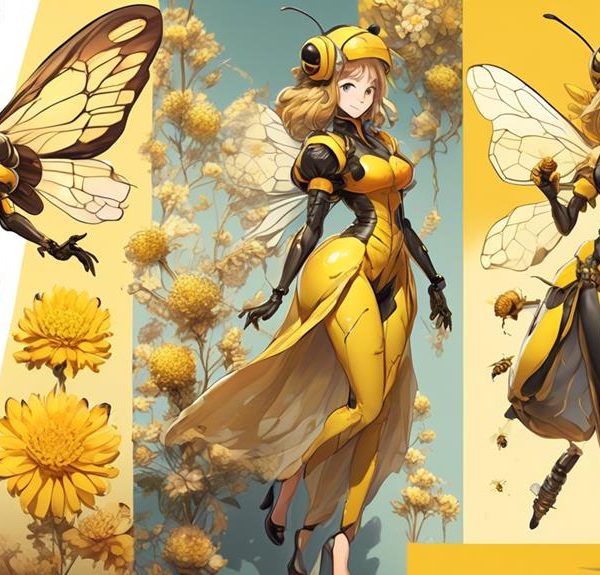Join us as we delve into the puzzling world of wood-eating bees, uncovering the hows and whys of their unusual dining habits.
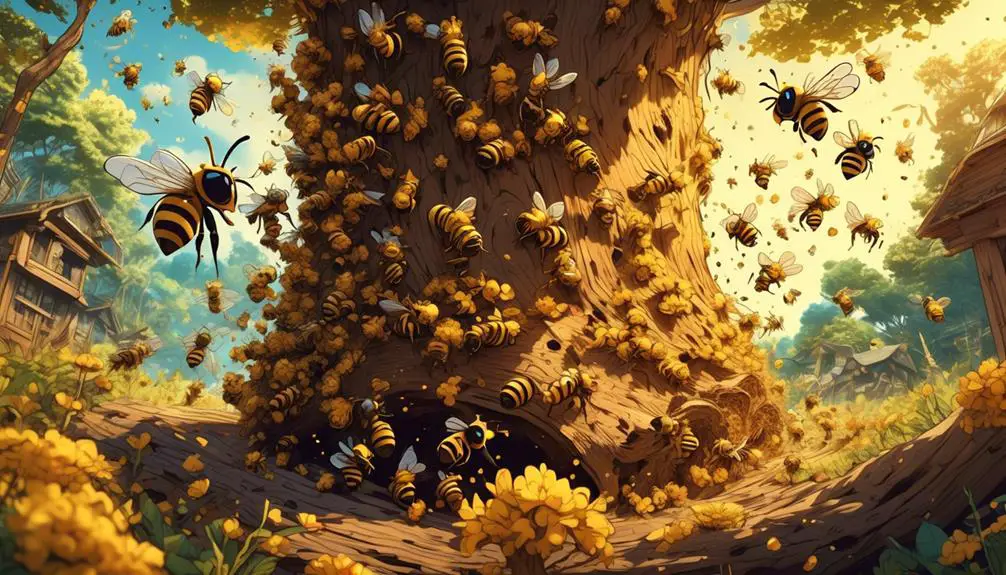
What Bees Eat Wood?
Like a detective piecing together clues, you're here to figure out a bizarre phenomenon: bees that eat wood. Yes, it's true, some species of bees don't just collect pollen and nectar, they actually consume wood.
Now you might be wondering how these small creatures manage to break down such tough material, and why they do it in the first place. But before we get to the heart of this fascinating mystery, let's set the stage by introducing you to the main culprits.
In doing so, we'll open up a world as intricate as the tunnels these bees carve into tree trunks.
Key Takeaways
- Carpenter bees, the primary wood-eating bees, do not eat wood for sustenance but rather to create nests.
- Wood-eating bees like carpenter bees and mason bees prefer weathered, unpainted softwoods such as pine, cedar, and redwood.
- Wood-eating bees primarily target dead or decaying wood, aiding in decomposition and promoting biodiversity.
- Painting or varnishing wood, sealing cracks and crevices, and regular inspections can help protect against wood-eating bees.
Understanding Wood-Eating Bees
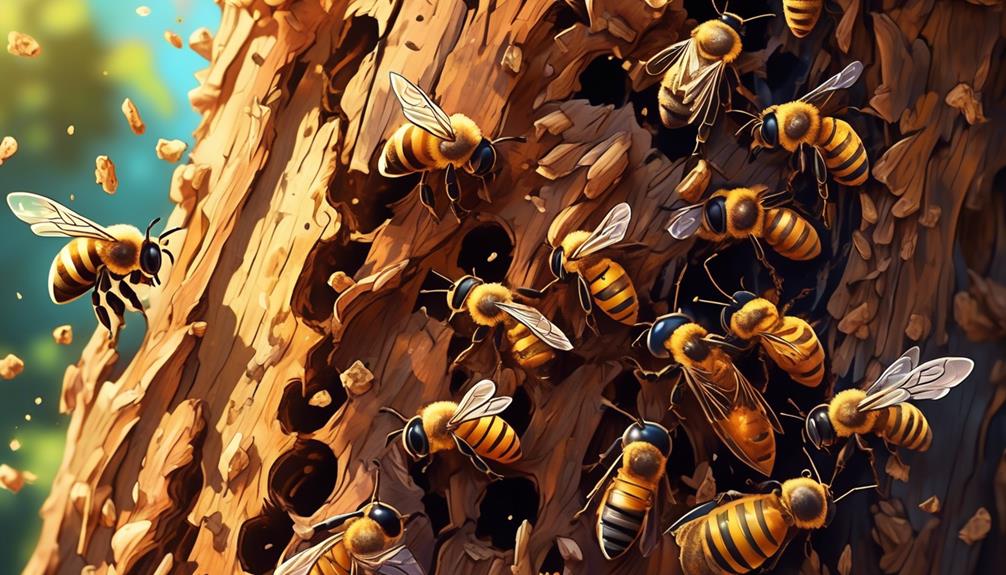
To comprehend the phenomenon of wood-eating bees, it's crucial to delve into their dietary habits, behavior, and the specific species that engage in this unique activity.
Not all bees are wood-eating; it's primarily carpenter bees that engage in this behavior. You might be wondering, 'Do they eat wood for sustenance?' The answer is no. These bees don't consume wood as food; they chew through it to create nests, leaving behind a sawdust-like material called frass.
Carpenter bees are solitary creatures, making individual nests rather than living in colonies. They prefer weathered, unpainted softwoods such as pine, cedar, and redwood. Females can chew a one-inch tunnel in just six days, making them quite formidable in their woodworking skills.
Despite their destructive tendencies, carpenter bees play a vital role in the ecosystem. As they move from flower to flower collecting nectar and pollen for sustenance, they inadvertently pollinate plants, contributing to biodiversity.
Understanding carpenter bees' behavior and dietary habits provides insight into their wood-eating activities. Although they can damage wooden structures, their ecological benefits can't be overlooked. Recognizing this balance is essential for both appreciating these insects and managing their impact on our wooden structures.
Main Species of Wood-Eating Bees
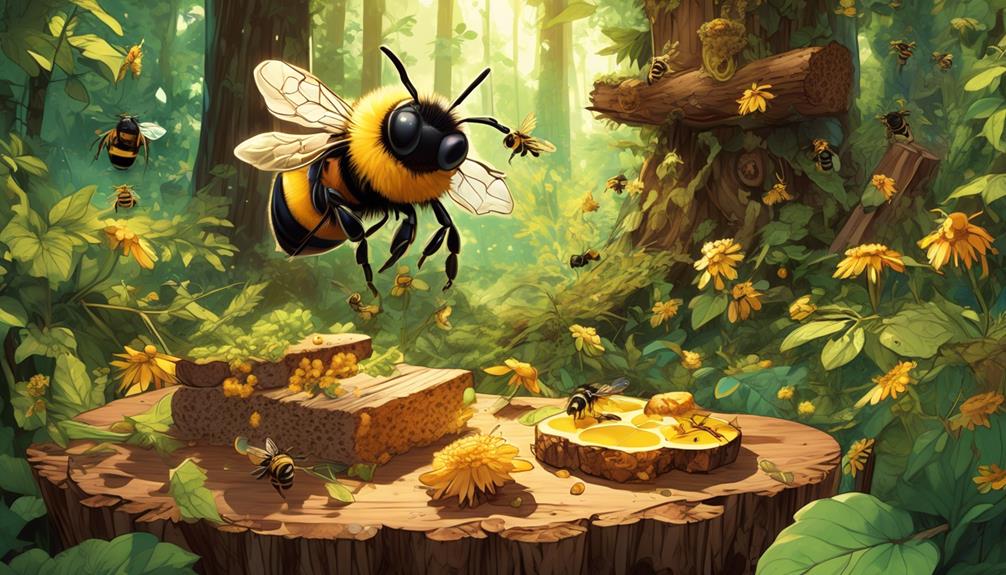
When you're identifying the primary species of wood-eating bees, the carpenter bee takes center stage, boasting several subspecies that display this distinctive behavior. This species, scientifically known as Xylocopa, encompasses around 500 varieties worldwide. They're renowned for their wood-boring habits, using their strong mandibles to chew tunnels into wood for nesting purposes.
It's crucial to distinguish carpenter bees from wood-eating termites. Rather than eating the wood, carpenter bees excavate it, leaving behind a tell-tale array of perfectly round holes. They're not consuming wood for sustenance; instead, they're adept at foraging nectar and pollen for nourishment.
Another noteworthy species is the mason bee, or Osmia. While not as notorious for wood-boring as carpenter bees, some mason bee species will opportunistically nest in soft, decayed wood. They're solitary bees, often using existing cavities for nesting instead of creating new ones.
The Wood-Eating Process Explained
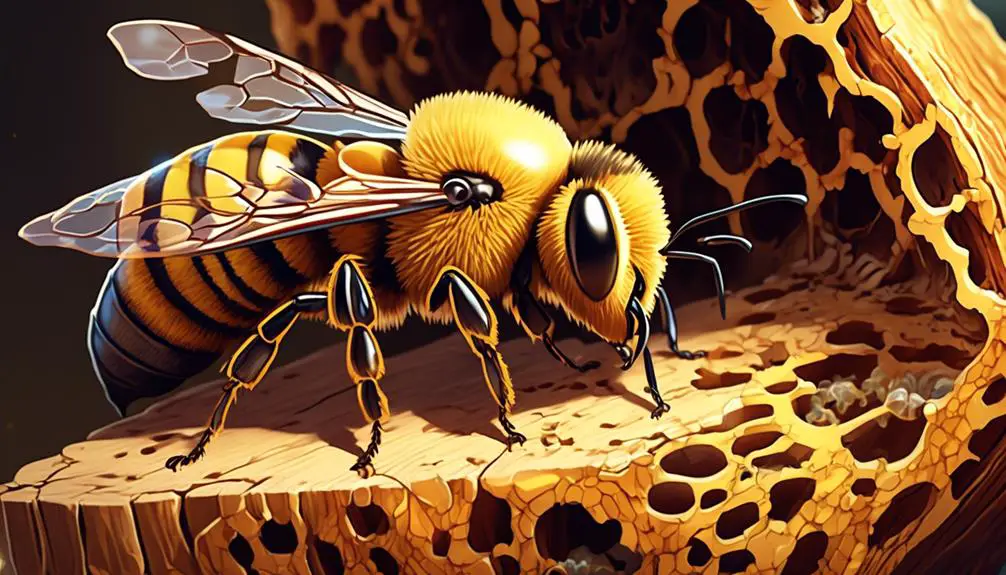
While understanding the types of bees that bore into wood is crucial, it's equally important to grasp how this process unfolds. You see, not all bees eat wood; most, in fact, do not. Wood-boring bees, like carpenter bees, use their strong mandibles to excavate wood, not consume it. They're not feasting on your garden fence, but rather, they're creating tunnels for nesting purposes.
The process begins when a female bee chooses a suitable piece of wood. She then starts to drill into the wood, using her mandibles and legs to push the wood particles out of the tunnel. This excavation process can take several weeks, resulting in a main gallery that's about 1 inch in diameter and 6-10 inches deep.
Inside, she lays her eggs and provisions them with a mixture of pollen and nectar, which serves as food for the larval bees.
Impact on Trees and Environment

Despite their seemingly destructive behavior, wood-boring bees actually have a minimal impact on healthy trees and can contribute to the overall ecosystem health.
You see, these industrious insects primarily target dead or decaying wood – the kind that's often found in fallen logs or aging structures. As they chew through this material, they're essentially recycling it back into the environment, aiding decomposition and nutrient cycling.
Furthermore, their excavations can create habitats for other species, promoting biodiversity. For instance, their abandoned tunnels often serve as nesting or hibernation sites for certain birds, mammals, and other insects. So while it might seem like they're causing harm, they're actually playing a crucial role in maintaining the balance of our ecosystems.
It's only when these bees target living trees or wooden structures that problems can occur. They can weaken a tree's structure, making it more susceptible to wind damage. They can also cause aesthetic damage to timber structures. However, these instances are relatively rare and can be controlled with targeted pest management strategies.
Protection Against Wood-Eating Bees
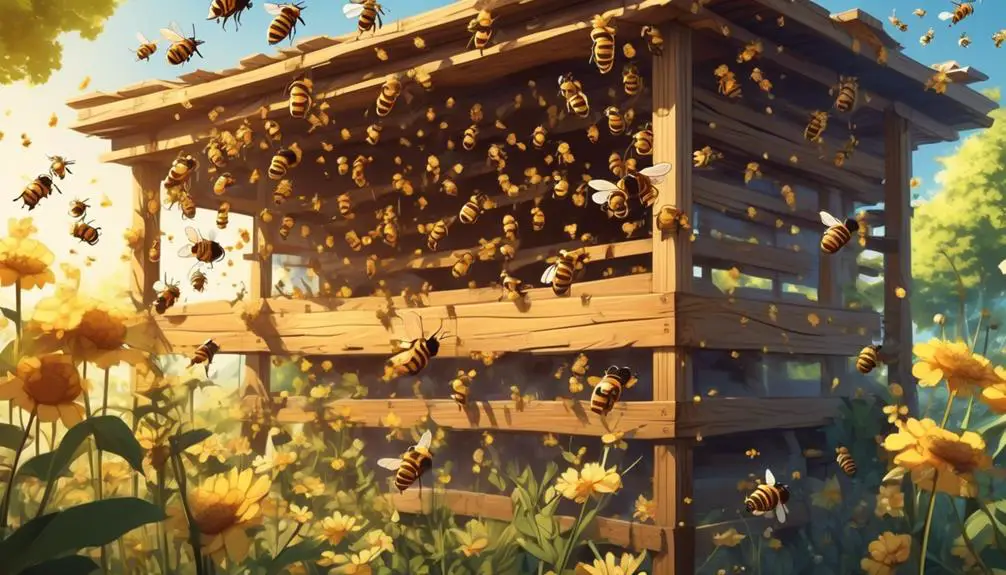
Understanding how to protect your property from wood-eating bees is essential, especially if you're living in an area where these insects are prevalent. Firstly, it's crucial to identify the problem. Signs include round, smooth holes in wood, a sawdust-like substance around these holes, and the bees themselves.
You can deter these bees by painting or varnishing your wood. These insects prefer untreated, exposed wood. So, a well-maintained, painted or varnished surface is less attractive to them. It's also beneficial to seal any cracks or crevices where bees could potentially nest.
If you've detected an active infestation, it's recommended to consult a pest control professional. DIY methods mightn't be effective against a large population and could potentially harm beneficial bees. Professionals have the knowledge and tools to handle the problem effectively and responsibly.
Additionally, regular inspections and early detection are key in managing wood-eating bees. If you spot any signs, take immediate action. Be vigilant, especially in warmer months when these insects are most active. Remember, prevention is better than cure when dealing with these wood-eating pests.
Fascinating Facts About Bees Diet
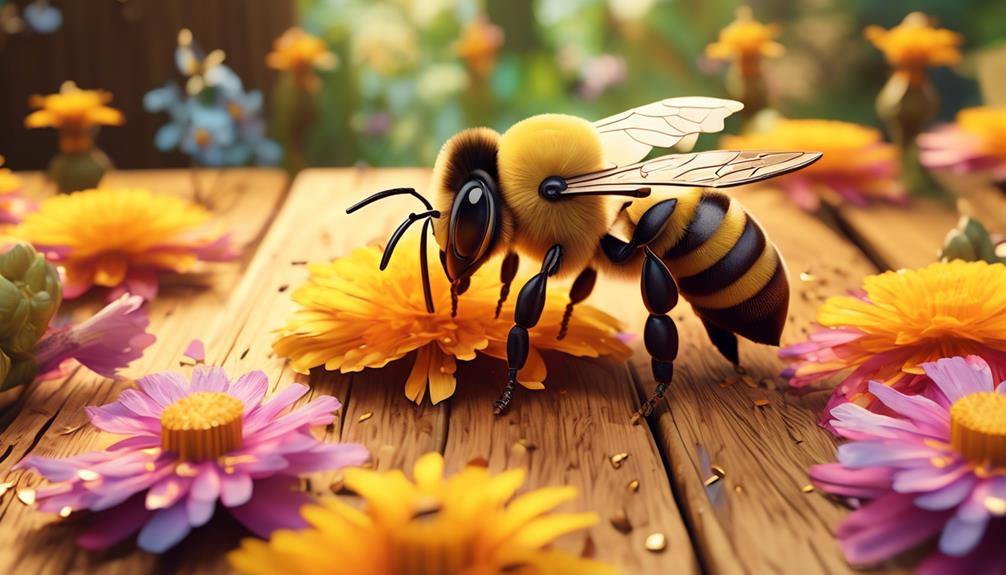
You might be surprised to learn that bees' dietary habits are as diverse and fascinating as the species themselves. While most bees feed on nectar and pollen, some species have more peculiar diets. For example, wood-eating bees, as their name suggests, consume wood to extract nutrients.
Let's delve into the diverse world of bee diets using the table below:
Bee Species | Primary Diet |
|---|---|
Honey Bees | Nectar and Pollen |
Carpenter Bees | Wood |
Leafcutter Bees | Leaves |
Sweat Bees | Sweat |
Bumblebee | Nectar and Pollen |
Honey bees are your typical pollen and nectar gatherers, but carpenter bees carve into wood to make nests and consume some in the process. Leafcutter bees, on the other hand, cut pieces of leaves to line their nests. Sweat bees are known to lick human sweat for its salt content. Bumblebees, like honey bees, rely on pollen and nectar.
Understanding these dietary habits is crucial for bee conservation efforts. As their diets indicate, bees need diverse habitats to survive. So, preserving their habitats helps maintain bee populations and the crucial pollination services they provide.
Frequently Asked Questions
What Other Insects Are Known to Eat Wood Besides Bees?
Besides bees, you'll find other insects that feast on wood. Termites are probably the most famous wood-eaters, causing significant damage to homes. Carpenter ants, too, create intricate tunnels through wood. Wood-boring beetles, specifically the larvae, consume wood as their primary diet. Lastly, horntail wasps' larvae bore into wood for nutrients.
It's interesting to see how diverse the insect world is when it comes to dietary preferences!
How Does the Diet of a Wood-Eating Bee Differ From That of a Honey Bee?
You may think all bees have the same diet, but they don't. Unlike honey bees, which feed on nectar and pollen, carpenter bees eat wood. They don't actually consume the wood for nutrients. Instead, they burrow into it to build nests.
Their diet mainly consists of nectar, like honey bees. The wood serves more as a home than a food source. The difference lies in their behavioral adaptation, rather than dietary needs.
Are There Any Benefits to the Ecosystem From Bees Eating Wood?
Yes, there are benefits to the ecosystem from bees eating wood.
Wood-eating bees, like carpenter bees, help decompose dead wood, returning nutrients to the soil.
They're also important pollinators.
Their wood-boring activities create habitats for other insects and birds.
How Does the Wood-Eating Habit of Bees Affect the Lifespan of the Bee?
You're wondering how a bee's lifespan is affected by its wood-eating habits.
Wood-eating doesn't directly influence a bee's lifespan. Bees don't actually consume wood but chew it to construct their nests.
The strain of this activity could potentially shorten their lifespan due to the energy exertion. However, it's important to remember other factors, like predators, disease, and environmental conditions, also play significant roles in determining a bee's life expectancy.
Can Wood-Eating Bees Pose a Threat or Cause Damage to Wooden Structures, Such as Houses or Furniture?
Yes, wood-eating bees can cause damage. They're not eating the wood for sustenance but rather to create nests. Carpenter bees specifically bore into wood to build their homes. Over time, this can cause structural damage to your wooden structures.
If you're noticing small, round holes in your wood, it's likely you've got a carpenter bee problem. Don't ignore it, get it checked out to prevent further damage.
Conclusion
So, you've discovered that bees don't actually eat wood, but rather, certain species bore into it to create nests.
This process, while potentially damaging to trees, plays an integral part in the ecosystem. Thankfully, protective measures can be taken to safeguard your trees.
Isn't it fascinating how diverse these tiny creatures' diets can be? Remember, understanding and respecting our buzzing friends is key to co-existing harmoniously with them.

